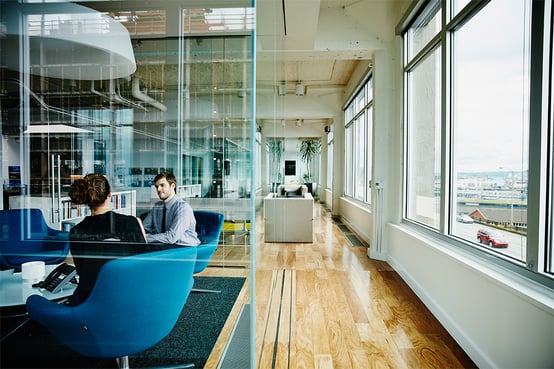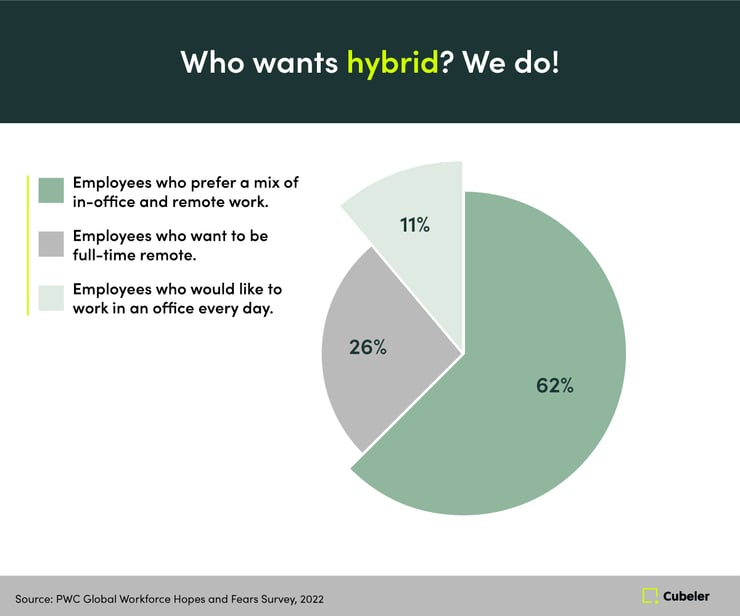Unlock the Power of Marketing: Get Your Free Marketing Plan Workbook
Enhance your marketing expertise with our free Marketing Plan Workbook, tailored specifically for small business owners...
7 min read
By:
Cubeler en-ca
21-Mar-2023 9:00:00 AM

Take action with the SME recommendations here for addressing today’s workforce challenges and staying resilient in an ever-evolving landscape. Gain insights into everything from creating a people strategy to upskilling talent and reimagining the office of the future.
The world of work is changing fast, and what employees want from their employers is changing with it. In this article, SME owners and managers can learn why the landscape has shifted, what challenges it brings, and harness actionable ideas for tackling today's workforce challenges and future-proofing your business for tomorrow.

We’ve had to shift the way we run our businesses, how we interact with our employees and colleagues, and when and where work gets done. It’s an evolution many companies are still figuring out.
Working from home during the pandemic gave employees greater autonomy and better work-life balance. Mental health became a greater focus as people struggled with stress, anxiety and depression. People started rethinking their priorities en masse—and left jobs that weren't flexible, manageable or fulfilling, kickstarting what has become known as the “Great Resignation.”
The Great Resignation has seen a quarter of Canadians change jobs and a 25% increase in US employees voluntarily leaving their roles. More than 50 million US workers quit their jobs in 2022 alone, which indicates that the great resignation isn't even close to being over.
As SME owners and managers, you know that the benefits of retaining good people are huge. But in a landscape where one in five workers is looking to leave their job and it's harder and harder to find and keep the right employees, how do we do that?
We do it by understanding—and embracing—the needs of the workforce of tomorrow.
But before we jump into the “how” of future-proofing your workforce, let's start by looking at why future-proofing needs to happen in the first place. There are four key factors contributing to this new world of work we're facing:
From process automation tools like CRM and ERP to robotics, AI and the increasing use of data analytics, technology is a vital part of business growth. But technology isn’t a solution in itself: companies need leaders who can identify the opportunities it can bring, effectively incorporate it into their operations through digital transformation—and ensure employees actually use it.
40% of US workers say they would quit if forced to go back to an office full-time. More and more companies are making the hybrid model part of their long-term workforce strategy. But what that actually looks like is still in flux as SMEs figure out how to support remote work—while still providing a great employee experience.
There aren’t enough skilled people to fill all the specialized jobs out there. Shifting demographics cut down the workforce even more: as baby boomers retire, there aren't enough younger workers coming in to replace them. The solution is to build those skills in your own workforce, helping your people develop the capabilities they need to adapt to an unpredictable, increasingly digital world.
There's constant pressure to do more with less: less money, less time, and fewer people, all amidst inflation and recession fears. Workers’ mindsets have changed along with the market: they are looking for a better work experience that includes flexibility, balance and the sense they're seen as “whole” people rather than just workers.

In 2022, PWC talked to 52,000 workers in 44 countries for their Global Workforce Hopes and Fears Survey. They found that while money is still the most important factor for employee satisfaction, it isn't the only one.
Compensation isn't enough to retain an employee: doing meaningful work matters a great deal. So does autonomy. And people want to work with leaders and colleagues who care about them, their well-being and their sense of fulfillment.
Gallup recently asked employees what they look at when deciding on a new job. 58% said being able to “do what they do best” is the most important thing. They want to do work that is meaningful to both them and the company. When they are fulfilled by their work, their performance improves, and so does their attitude towards their job.
The pandemic blurred the lines between professional and personal lives. For the first time, companies had to acknowledge that their employees are also parents, partners and caregivers, and that they face personal struggles and mental health challenges.
Workers are now looking for caring leaders who “get” the challenges they face, provide psychological safety to have open discussions, and demonstrate trust, openness, transparency and follow-through.
The pandemic saw a 25% jump in anxiety and depression globally. PWC’s Canadian Office Workers Survey 2021 found that for 46% of employees, mental health issues have been one of their biggest challenges since the pandemic. SMEs need to continue supporting mental and physical well-being.
You can throw all the money you want at wellness programs. But if employees face overwhelming workloads and the pressure to be “on” 24/7, even the best-intentioned programs will fail. Burnout is the leading cause of resignation.
In a recent LinkedIn survey, 63% of people said work-life balance is more important to them than compensation. And in a Gallup poll, 61% said better balance and personal well-being are their top considerations.

Here are some numbers to consider:
62% of respondents in PWC’s Hopes and Dreams survey said they prefer a mix of in-office and remote work.
26% want to be full-time remote.
Only 11% are looking to be in an office every day.
Being able to choose when and where to work empowers people, giving them autonomy and helping maintain work-life balance. However, that's a big mismatch with what companies want.
Due to productivity paranoia, even organizations that were initially on board with remote work after the pandemic are bringing people back to the office.
It’s also important to remember that not every job can be done remotely. Any hybrid work model needs to take those employees into consideration as well, or you face leaving a chunk of your workforce disempowered and disengaged.
And then there's the other end of the spectrum: full-time remote workers don't want to miss out on opportunities either.
These numbers speak volumes:
76% of employees would stay at their company longer, if they got more learning and development support.
66% would stick around if it was easier to change jobs internally.
Only 28% of Canadian employees say their company is addressing skills shortages by upskilling their existing workers.
Employees want to learn and grow: they are eager to get the specialized skills they need to be part of a future-proof workforce.
Companies are being asked to communicate better about environmental, social and governance issues.
In the PWC study, here’s what the researchers found:
54% of Canadian employees would like more transparency around how employers are addressing diversity, equity and inclusion.
53% want to know about the impact the business has on the environment.
Good intentions aren't enough to build a healthy, skilled and engaged workforce. You need a strategy that puts the employee experience front and centre.
Ask them what they need. Gather data on employee sentiment in meetings, surveys and one-on-ones.
Address their concerns. According to PWC’s Canadian Office Workers Survey 2021, “most organizations will need to align their purpose and trust agenda, create the right environment for employees to address social and political issues, commit to pay transparency, double down on inclusion and invest in leadership development.”
Transform your HR function. Make smart hiring part of your people strategy with labour market intelligence. Leverage talent analytics and adapt your hiring to emerging workforce trends. Create short- and long-term plans for hiring the right skills and attitudes. Adopt blind recruitment, removing applicant names from resumes to prevent bias and increase diversity.
Talk about your people strategy. A lot. Show employees you’re listening to their needs. Send emails to share your people strategy. Talk about the company’s workforce priorities in meetings and town halls. Put up signs in the office. Post messages on social media. Add it to email signatures. Overcommunicate to really get your message out.
Get your employees involved. Try crowdsourcing your mission and values statements from the people who have to live them—it's a much better way to ensure authenticity and get buy-in than imposing “values from above.” It doesn't have to be a complicated corporate exercise: smaller businesses can use SurveyMonkey or host a working session to get their employees involved.
Determine what skills you need now and what you'll need in the future. Then, offer your employees modern, meaningful learning, development and upskilling programs with an investment in solid educational technology.
Most employees want a hybrid working model: imposing a full-time return to the office could mean losing valued people. There is no perfect ratio of in-office and remote, but it's okay to experiment and see what works best. Do everything you can to support remote work via technology and equitable policies around pay, promotion and rewards to prevent proximity bias.
Find out what makes work meaningful to individuals and be creative about including those things in their day-to-day. A few ideas:
Look to employees to help determine your vision, mission and values.
Kick off team meetings with high-impact stories.
Share customer feedback or give them the opportunity to connect directly with customers.
Keep employees updated about how the company is helping the community and the environment.
Recognize people’s contributions one-on–one, with emails, company-wide shout-outs or a peer-to-peer recognition program.
Have everyone on the team take turns leading meetings.
Set up mentorship opportunities: connect senior people with those looking to learn, or implement something fun like shadowing the owner for the day.
Find ways to automate or outsource menial tasks so your employees can focus on work that matters to them.
According to PWC's 25th CEO Survey – Canadian Insights, leaders tend to focus on things like company updates and rewards to build trust with employees. Only 31% think addressing when, where and how people work is an important part of building engagement. That’s a pretty big disconnect with what workers want.
Out of sight can mean out of mind for remote workers: we perceive the people we work with most closely as the most productive. Look at productivity with a fact-based lens to ensure that no matter where or when people are doing their jobs, they are evaluated fairly for the work they accomplish.
What’s the productivity paradox? 41% of those who responded to PWC's Canadian Office Worker Survey in 2021 said working from home increased their productivity. But 85% of leaders don’t have confidence that people are being productive when they aren’t in the office.
There are a few things SMEs can do to future-proof your business in the work world of tomorrow:
Employees want to feel fulfilled at work, so find ways to add meaning by automating menial tasks and enabling them to do what they do best. Share high-impact stories and customer testimonials. Recognize them for their hard work and innovation.
Employees would like to be treated as people, not just as workers. Support their mental health with formal programs, but also with sustainable workloads and a focus on work-life balance. Lead with empathy, trust and transparency.
Offer as much flexibility as you can, with a mix of in-office and remote work that’s optimized to the specific needs of your company.
Be aware of the gap between perceived and actual productivity. Just because you can’t see them doesn’t mean they aren’t working. And just because you can doesn’t mean they are.
Companies need skills and employees are hungry for training and upskilling. Providing training and professional growth opportunities will help you retain talent and get the specialized skills you need in-house.

Enhance your marketing expertise with our free Marketing Plan Workbook, tailored specifically for small business owners...

Find out what you need to know to bypass the most common marketing pitfalls.

Expand your SME business network the right way. Learn how to connect with like-minded SME owners and decision-makers to...